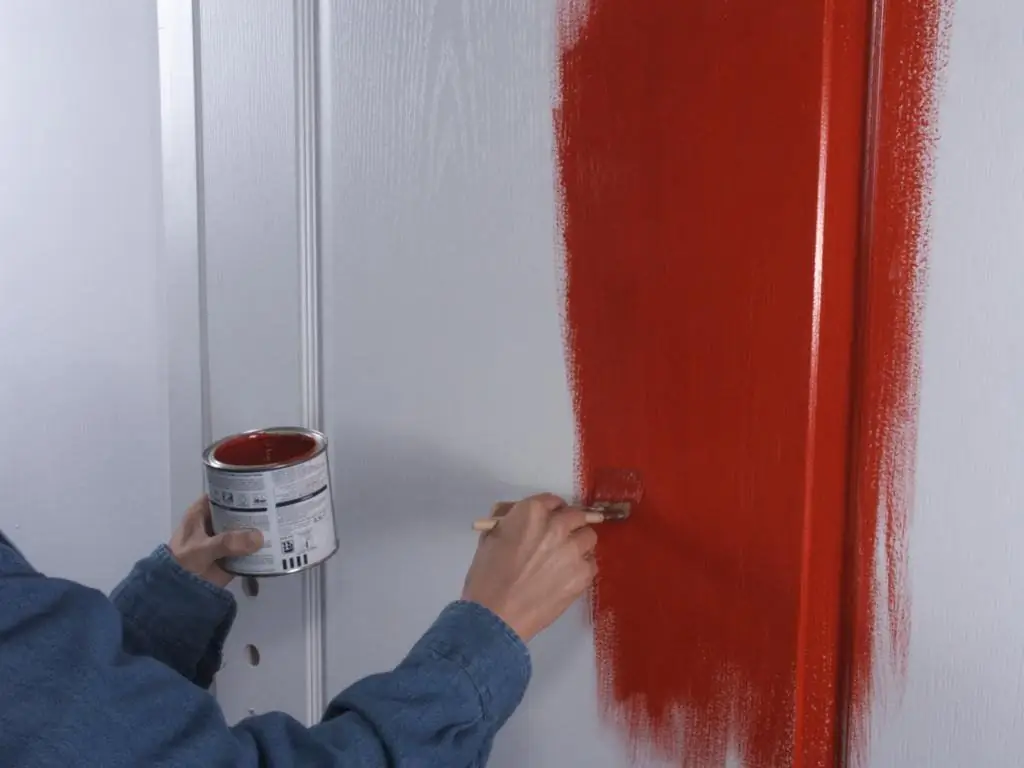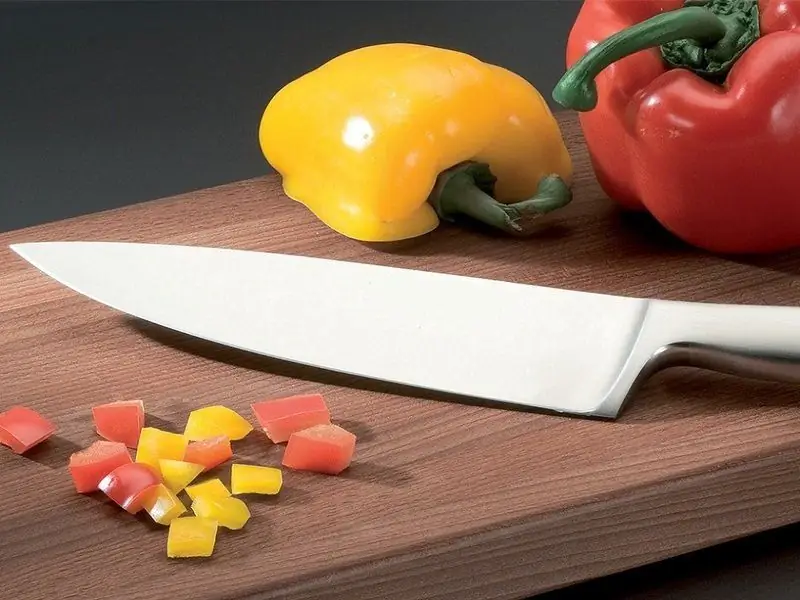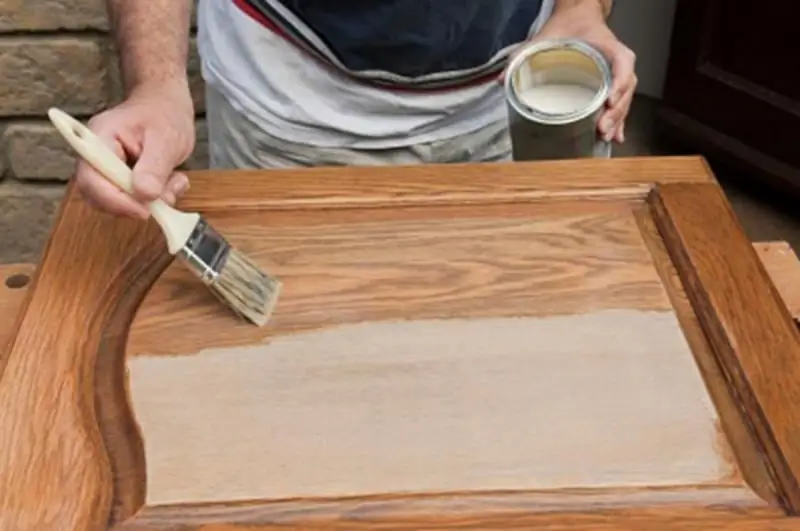
Table of contents:
- Author Bailey Albertson [email protected].
- Public 2023-12-17 12:53.
- Last modified 2025-01-23 12:41.
How to paint wooden doors: tools and technologies

Wood is ideal for making doors, but it needs protection. Coloring allows you to extend the service life and give your doors a beautiful appearance.
Content
-
1 How to prepare wooden doors for painting
-
1.1 Removing old paint from a door
1.1.1 Video: thermal method for removing paint from wood
-
1.2 Processing the door before painting
1.2.1 Video: sanding a wood board
-
-
2 The choice of paint for wooden doors
2.1 Video: choosing paint for wood
-
3 Wood door treatment: paint application
3.1 Video: painting a wooden door with a roller
-
4 Door varnish technology
4.1 Video: step-by-step restoration and door varnishing
-
5 Painting the door with a stain
5.1 Video: applying wood stain
How to prepare wooden doors for painting
The application of paint and varnish components requires the preparation of a wooden surface. This is necessary to improve adhesion between the coating and the substrate, as well as even distribution of paint or varnish. You can carry out the preparation yourself, since there is no need for a specially equipped room and professional tools. Moreover, the technology of this process is common both for the old and already painted, and for the new structure. But in the first case, the removal of the existing coating is required, and further actions are optimal for any wooden canvas.

Correct door preparation is the key to perfect staining
For proper preparation, the type of wood from which the product is made is not important. Use comfortable and quality tools. If the wood is hard, then you need to put more effort into processing it. Doors made of pine or other soft solid wood options require careful handling.
Removing old paint from a door
When preparing an old door for renovation, it may be necessary to remove the old paint that covers the product. With the help of such an event, you can completely transform a canvas that has lost its beautiful appearance.

The paint can be removed in different ways, but it is important to treat all areas of the work surface.
Thermal, chemical or mechanical methods can be used to remove flaky and old coatings. The technology features are expressed in the following:
- during thermal removal of the coating, a building hair dryer is used, with which the surface is heated, and the softened paint is removed with a spatula;
- the chemical method involves applying a special chemical wash to the door, the waiting time is about 5-10 minutes for the agent to work, then the paint is scraped off with a spatula;
- the mechanical method involves processing a wooden door with hard sandpaper, a grinding machine, that is, removing the paint by friction.

After applying the remover, the paint can be easily removed with a spatula
Chemical and thermal methods make it possible to quickly clean the product from the old coating. To implement the mechanical method requires time and physical costs, which is not always convenient.
Video: thermal method for removing paint from wood
Door treatment before painting
After removing the paint, an old door or a new product is sanded before coating. This process involves the maximum smoothing of the wood structure for an even distribution of the paint and varnish composition. If there are small dents, cracks on the canvas, then they must be covered with acrylic putty to match the color of the wood. After this product has dried, they begin sanding, which is carried out along the fibers.

The sanding process removes unevenness on the door and ensures a smooth finish
If bath, entrance wooden doors are processed, then after sanding it is necessary to apply an antiseptic agent and a fire retardant to the wood. These substances can be purchased at home improvement stores, and they are applied to the canvas with a brush, spreading in a thin layer. To increase the service life, interior doors are often treated with an antiseptic.
Video: sanding a wood shield
The choice of paint for wooden doors
To create a dense and uniform coating, use a paint suitable for processing wood products. Such funds are presented in a wide variety and therefore, when choosing, you need to take into account certain features, for example, the operating conditions of the paint, the method of application. The composition is also selected depending on where the doors are located. For example, the entrance canvases are significantly affected by ultraviolet radiation and moisture, and the paint should protect the material from deformation as much as possible.

Door paint can be of any color, but its high performance is important
The choice of paint is carried out taking into account the following features of the placement of doors:
- for entrance doors, you need a product intended for outdoor use, resistant to low and high temperatures, humidity and ultraviolet rays. The paint should provide a dense coating to protect the surface from mechanical stress;
- for interior doors, compositions are optimal that do not have a pungent odor and form a resistant, durable, high-quality coating;
- doors to the bathroom and other rooms with high humidity must be painted with compounds that are resistant to temperature extremes, moisture, and protect the product from decay.

The paint for the door must be dense and provide a durable finish.
Manufacturers produce many options for products, each of which has certain characteristics. Compositions suitable for wood are:
- acrylic paint belongs to the group of water-dispersible paint and provides a dense coating. The product has a homogeneous structure and is easy to apply to a wooden surface. Acrylic paint is suitable for interior doors installed in rooms with low humidity levels;
- alkyd compositions are based on a complex of thick resin, rosin, glycerin and vegetable oils. Enamels of this type require drying within 2-3 days, protect the wood from decay and form a durable coating that is resistant to abrasion. Suitable for outdoor use;
- polyurethane products create a reliable coating that perfectly protects the wood from moisture and scratches. The composition is comfortably applied, as it is characterized by elasticity.

High-quality paint makes the door beautiful and provides a durable finish
When choosing a wood treatment product, you need to carefully study the information provided by the manufacturer and indicated on the label. This will determine the purpose of a specific paint option and the compliance of the product characteristics with the required level. For example, an entrance door requires an outdoor material that is highly frost resistant, forms a dense coating and can withstand exposure to UV rays. The impregnation, varnish or paint must have the same base, otherwise the coating will quickly delaminate.
Video: choosing paint for wood
youtube.com/watch?v=vj-f-ToQ_00
Wooden door treatment: paint application
Painting a natural wood door requires certain tools. You can apply the composition with a brush or a special spray gun. In the first case, it is important to carefully and evenly distribute the product, and in the second, the application is simple, but also requires precision of movements. The use of a brush is optimal at home, since there is no need to prepare the place for staining. It is even possible not to remove the door from its hinges, but only to close those places that should not be painted with film and masking tape. But in this case, you need to pick up a small amount of material on the brush to avoid dripping.

Painting the door with a brush can be done at home
Work with a spray gun is carried out in a utility room or outdoors in dry and warm weather. It is important to avoid dust getting on the surface to be painted, which is necessary to obtain an even coating. Processing the door with a spray gun involves the following steps:
-
Applying masking tape to areas not exposed to staining. Long self-tapping screws are screwed into the upper and lower parts of the frame, and then the canvas is placed between two supports, that is, it must be in a suspended state.

Painting the door with a spray gun The door leaf for painting can be placed on special supports
-
Preparation and stirring of the dye, mixing the components if necessary (follow the manufacturer's recommendations indicated on the package label). If the product is thick, then it must be diluted with suitable components, as indicated on the label. Placing the composition in a special container of the spray gun, test staining of test boards.

Spray gun device diagram The paint composition is placed in the spray gun tank
-
By the method of short sprays, paint is applied to the surface. All areas of the canvas, paneling and other complex structural elements are carefully processed. After the first layer has dried, apply a second, if necessary.

Painting scheme for a wooden paneled door The paint is applied along the grain of the wood, which is important when using a spray gun, roller or brush
If the door is varnished, then sandpaper is treated with opaque compounds. This will improve the adhesion of the paint to the varnished structure. Only then can the paint be applied using the selected method: roller, brush or spray gun.
Video: painting a wooden door with a roller
Door varnish technology
The method of applying varnish to a wooden door is slightly different from applying paint, but you can also use a brush or spray gun to work with it. In the second case, a more even thin layer will be obtained, emphasizing the natural structure of the wood.

The use of varnish allows you to make the door beautiful and emphasize the wood structure
The varnish is presented in a wide variety and therefore it is important to know the characteristics of the main options. Their classification differs depending on the area of application, but the funds differ significantly in composition. So, the following options are distinguished:
- water-based acrylic varnishes are used only for interior work, as they have low resistance to humidity, mechanical stress, temperature extremes;
- alkyd varnishes contain resins and vegetable oils, which makes them versatile, they are applicable for indoor and outdoor use;
- oily formulations form a thick and durable coating with a gloss. The drying period of the layer is about 48 hours;
- nitro lacquers are optimal for interior work, dry within 15-25 minutes, apply them in several layers;
- epoxy varnishes require mixing of two components in the right proportions, can be used for external or internal work.

To obtain an even layer, the varnish is thoroughly mixed
In order to varnish a wooden door, you need to carry out the following steps:
-
Study of the instructions for use of the used wood varnish. The composition must be slowly and thoroughly stirred, which will ensure uniformity of color and quality of the coating.

Varnish for wood Any varnish should be thoroughly mixed before use.
-
The prepared composition is poured into the spray gun tank connected to the compressor. Test spraying is carried out on a test board. The door leaf is placed on supports, as in the case of using paint. After that, they begin to apply the product.

Coating the door with varnish The varnish is applied evenly and in several layers
-
The composition is applied along the wood structure, keeping equal, but very short sprays between sprays. After the first layer has completely dried, you need to process the doors with a grinder with fine-grained sandpaper, remove the dust and proceed with further actions. The second and subsequent layers are made only after each previous one has dried.

Varnished door The lacquered door looks solid and stylish
Brush application is possible without removing the door from the hinges. In this case, the coating will be very different from the surface treated with a spray gun.
Video: step-by-step restoration and varnishing of the door
Staining the door
Stain is a colored component that not only gives the wood a shade, but also protects the product from decay. Such a product has a liquid consistency and can be applied with a spray gun or brush. Stains are presented in the following variants:
- water-based compounds easily penetrate the wood structure and emphasize it, but the product dries for a long time and makes the surface rough;
- solvent-based stain provides a smooth surface, has a strong odor and dries fairly quickly after application;
- oil and wax versions of the stain are environmentally friendly and suitable for processing children's furniture, interior doors.

Stain may contain protective components
When choosing a stain, it is important to take into account its purpose, for example, the product may be optimal for outdoor use. If you process the front door with a tool for interior work, then the canvas will not be sufficiently protected from moisture, and will also quickly lose color.
The stain technology is similar to the varnish or paint method. The main actions are expressed in the following:
- Placing the canvas on supports, preparing and mixing the product.
- Test spraying the stain with a spray gun or brushing on the test board.
- Spray or paint evenly with a brush in one layer of the door leaf.

The stain is applied in a thin layer and evenly
The gap between sprays or brush strokes should be kept to a minimum. This will avoid highlighting borders and hue differences.
Video: wood stain application
Painting wooden doors necessarily involves choosing a product that meets the operating conditions of the product. After that, the processing technology is carried out, and the result depends on the thoroughness of preparing the canvas for painting.
Recommended:
How To Choose A Kitchen Knife: Which Company Is Better And From Which Material

Rules for choosing knives for work in the kitchen. Types of knives, their distinctive qualities. Selection criteria, best manufacturers
Do-it-yourself Painting Of Doors: Features For Different Types Of Canvas, The Choice Of Paint And Varnish, Stages Of Work

Door leaf coating technology. Preparatory work before painting. Selection of materials and tools. Sequence of work. Photo and video
Restoration Of Wooden Doors: Painting, Paneling And Varnishing

When is the restoration of doors needed and what materials are used for this? Restoration methods and their features for wooden doors
Installation Of Wooden Doors, As Well As How To Properly Dismantle

How to correctly measure the doorway. How to do this if the door is not dismantled. Do-it-yourself installation of a swing and sliding structure
How To Paint Interior Doors, What Paint To Choose For Various Surfaces

How to choose paint for interior doors from different materials. Preparation and processing of the door. Removing the old coating
